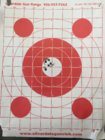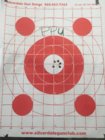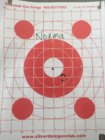Bullet failures/leaking lead can also be an issue with an individual barrel - not necessarily a jacket thickness/material issue. Via yet another long-for-caliber ordeal, involving FB bullets (in this instance, 6mm 108/104 Gr.), I purchased a pair of barrels (1:8" twist 3-groove) from a respected barrel maker, and chambered both using a 6/250 Ack/ Imp. reamer.
I had my pal, Tom, select which of the two barrels would be his, and chambered it first, then, did the second for myself: as soon as the Oehler displayed 2800 FPS, Tom's barrel destroyed every one of my FB bullets (J4 jackets), and eventually, every bullet, of every brand, except the LAPUA Scenar (I believe 105 Gr. BT). I have never been able to cause a bullet failure via my barrel - not even at deliberately excessive pressure.
As usual, I'm late to the party: spewing lead sure looks like molten/vaporized lead to me. An experiment we did was, heaven forbid, to shorten barrels, which did eliminate bullet failures - acceleration (referred to earlier, by someone) results in exponentially increasing friction/heat.
We also had some success shortening the bearing surface, via adding a BT.
Another failure reducer/eliminator: dry-film lubricant coating, which, in the case to Tom's, "bullet wrecker" barrel, reduced failures from 100%, to 10% . . . while not eliminated, a notable reduction. Dry-film lubricating is cheap insurance for a barrel which does not wreck bullets, but requires faster then 1:9" twist rate, in combination with all of the other variable attributes common to barrels, jackets and bullets. Long/heavy for caliber bullets, properly stabilized, as Dave pointed out, are very close to the edge . . .

Sadly, Tom tossed the "bullet wrecker" (checker) BBL when I wasn't looking - damn!

Since then, having fallen under the influence of one George Ulrich, I have messes around with "drawing-back" (annealing) various jackets - especially J4 - and have enjoyed pretty favorable results: very good precision and greatly reduced bullet failures. Should know more by end of upcoming LR season, as pal, Tim G. will probably be shootin' some at 600 & 1K, via faster than 1:7" twist .224 Cal. BBLs, which have consistently destroyed most of the long/heavy .22 Cal offerings.


RG














